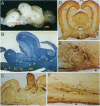Abstract
Two types of central nervous system integrators are critical for oculomotor performance. The first integrates velocity commands to create position signals that hold fixation of the eye. The second stores relative velocity of the head and visual surround to stabilize gaze both during and after the occurrence of continuous self and world motion. We have used recordings from single neurons to establish that the "position" and "velocity" integrators for horizontal eye movement occupy adjacent, but nonoverlapping, locations in the goldfish medulla. Lidocaine inactivation of each integrator results in the eye movement deficits expected if horizontal eye position and velocity signals are processed separately. These observations also indicate that each brainstem compartment generates and stores these signals. Consequently, each integrator exhibits functional autonomy. Therefore, we propose that the intrinsic electrophysiological properties of the constituent neurons in each brainstem subnucleus may be sufficient for producing integrator rhythmicity.
Full text
PDF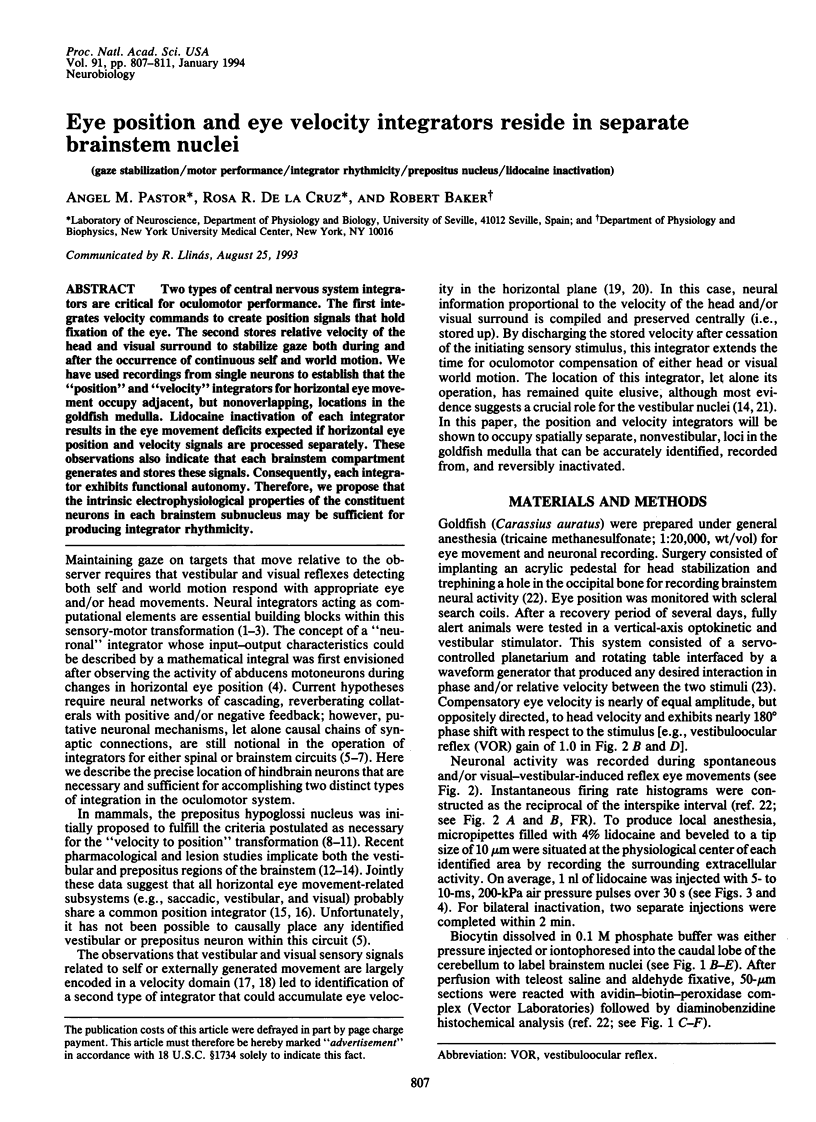
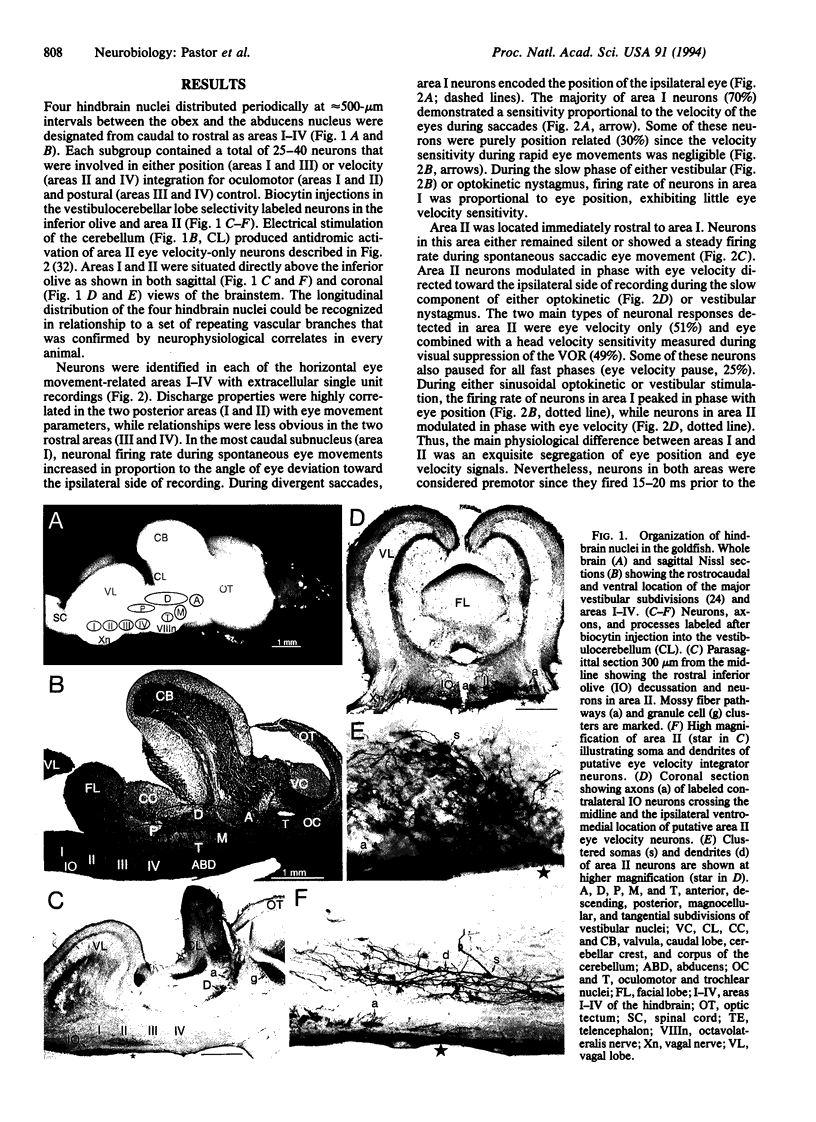
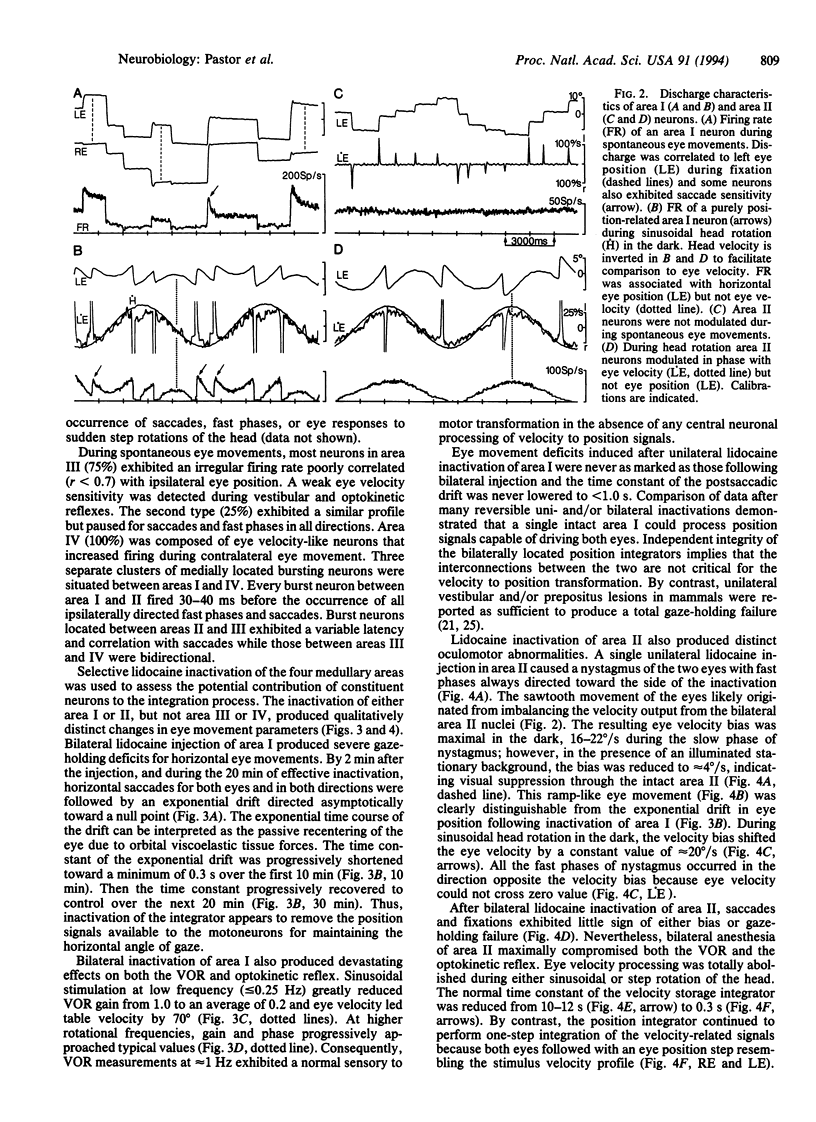
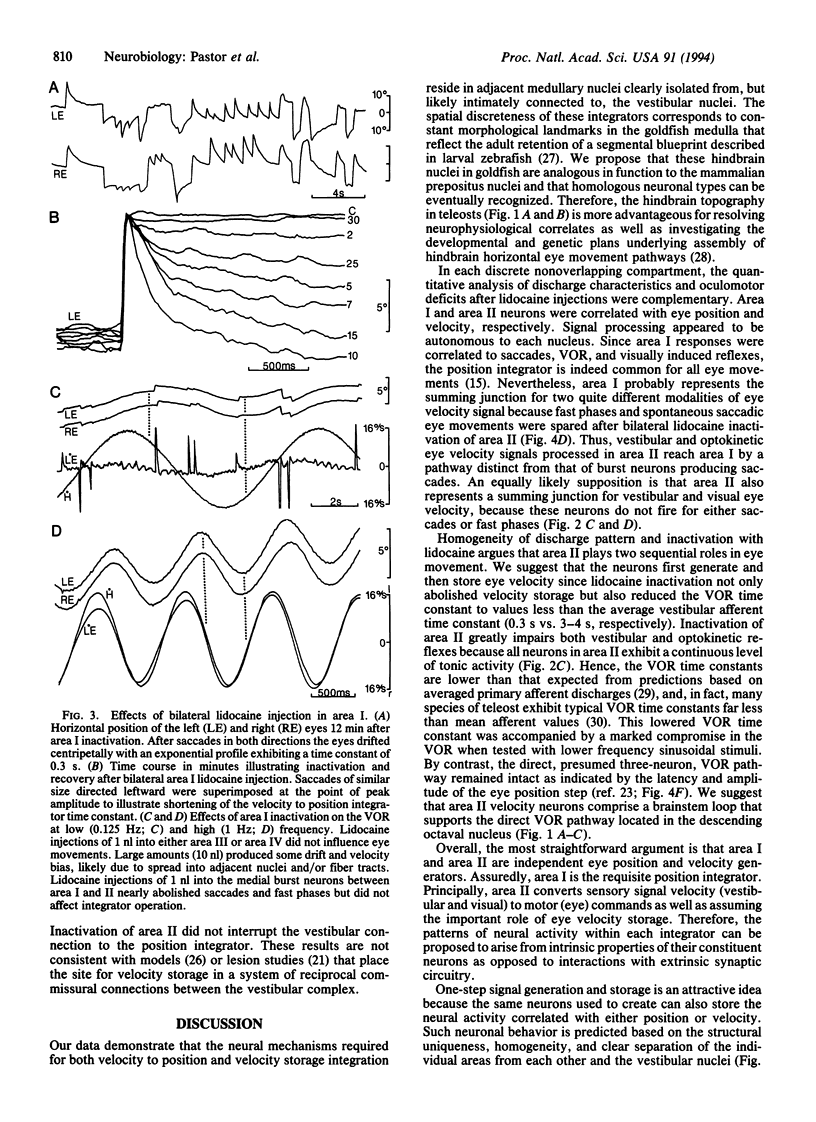
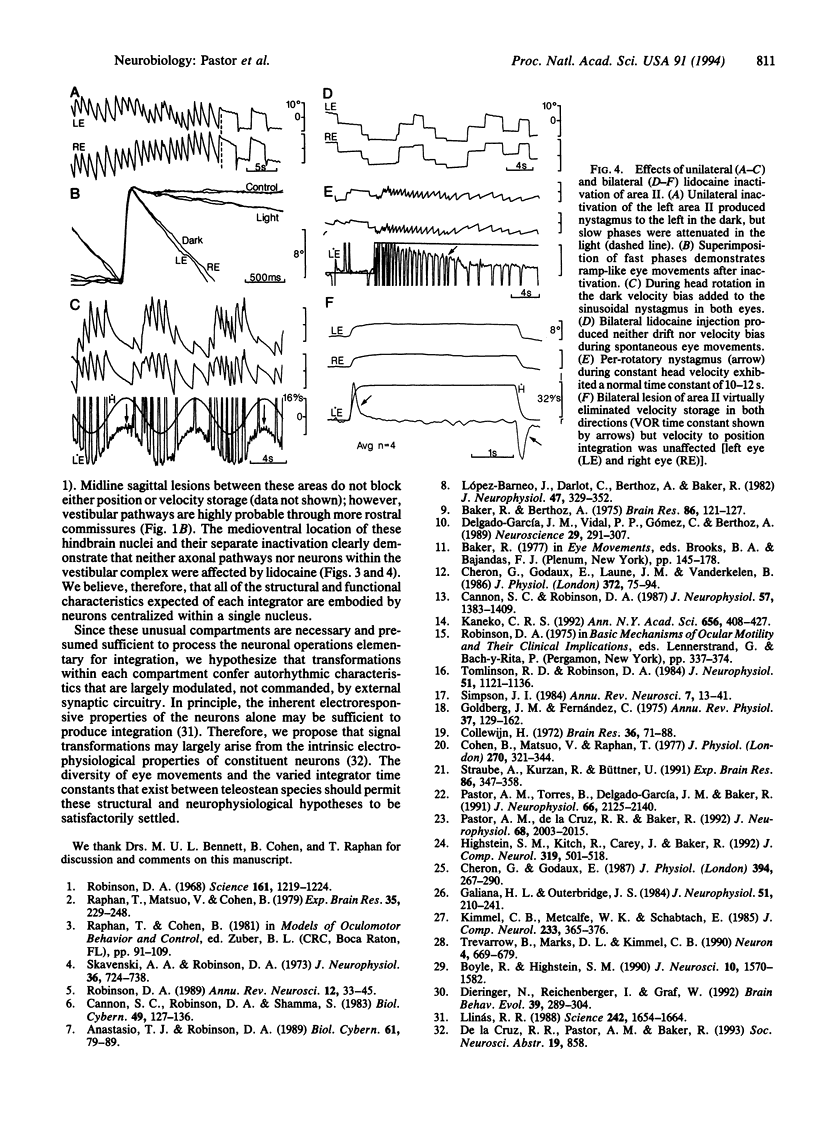
Images in this article
Selected References
These references are in PubMed. This may not be the complete list of references from this article.
- Anastasio T. J., Robinson D. A. The distributed representation of vestibulo-oculomotor signals by brain-stem neurons. Biol Cybern. 1989;61(2):79–88. doi: 10.1007/BF00204592. [DOI] [PubMed] [Google Scholar]
- Boyle R., Highstein S. M. Efferent vestibular system in the toadfish: action upon horizontal semicircular canal afferents. J Neurosci. 1990 May;10(5):1570–1582. doi: 10.1523/JNEUROSCI.10-05-01570.1990. [DOI] [PMC free article] [PubMed] [Google Scholar]
- Cannon S. C., Robinson D. A. Loss of the neural integrator of the oculomotor system from brain stem lesions in monkey. J Neurophysiol. 1987 May;57(5):1383–1409. doi: 10.1152/jn.1987.57.5.1383. [DOI] [PubMed] [Google Scholar]
- Cannon S. C., Robinson D. A., Shamma S. A proposed neural network for the integrator of the oculomotor system. Biol Cybern. 1983;49(2):127–136. doi: 10.1007/BF00320393. [DOI] [PubMed] [Google Scholar]
- Cheron G., Godaux E. Disabling of the oculomotor neural integrator by kainic acid injections in the prepositus-vestibular complex of the cat. J Physiol. 1987 Dec;394:267–290. doi: 10.1113/jphysiol.1987.sp016870. [DOI] [PMC free article] [PubMed] [Google Scholar]
- Cheron G., Godaux E., Laune J. M., Vanderkelen B. Lesions in the cat prepositus complex: effects on the vestibulo-ocular reflex and saccades. J Physiol. 1986 Mar;372:75–94. doi: 10.1113/jphysiol.1986.sp015998. [DOI] [PMC free article] [PubMed] [Google Scholar]
- Cohen B., Matsuo V., Raphan T. Quantitative analysis of the velocity characteristics of optokinetic nystagmus and optokinetic after-nystagmus. J Physiol. 1977 Sep;270(2):321–344. doi: 10.1113/jphysiol.1977.sp011955. [DOI] [PMC free article] [PubMed] [Google Scholar]
- Delgado-García J. M., Vidal P. P., Gómez C., Berthoz A. A neurophysiological study of prepositus hypoglossi neurons projecting to oculomotor and preoculomotor nuclei in the alert cat. Neuroscience. 1989;29(2):291–307. doi: 10.1016/0306-4522(89)90058-4. [DOI] [PubMed] [Google Scholar]
- Dieringer N., Reichenberger I., Graf W. Differences in optokinetic and vestibular ocular reflex performance in teleosts and their relationship to different life styles. Brain Behav Evol. 1992;39(5):289–304. doi: 10.1159/000114126. [DOI] [PubMed] [Google Scholar]
- Galiana H. L., Outerbridge J. S. A bilateral model for central neural pathways in vestibuloocular reflex. J Neurophysiol. 1984 Feb;51(2):210–241. doi: 10.1152/jn.1984.51.2.210. [DOI] [PubMed] [Google Scholar]
- Goldberg J. M., Fernández C. Vestibular mechanisms. Annu Rev Physiol. 1975;37:129–162. doi: 10.1146/annurev.ph.37.030175.001021. [DOI] [PubMed] [Google Scholar]
- Highstein S. M., Kitch R., Carey J., Baker R. Anatomical organization of the brainstem octavolateralis area of the oyster toadfish, Opsanus tau. J Comp Neurol. 1992 May 22;319(4):501–518. doi: 10.1002/cne.903190404. [DOI] [PubMed] [Google Scholar]
- Kaneko C. R. Effects of ibotenic acid lesions of nucleus prepositus hypoglossi on optokinetic and vestibular eye movements in the alert, trained monkey. Ann N Y Acad Sci. 1992 May 22;656:408–427. doi: 10.1111/j.1749-6632.1992.tb25225.x. [DOI] [PubMed] [Google Scholar]
- Kimmel C. B., Metcalfe W. K., Schabtach E. T reticular interneurons: a class of serially repeating cells in the zebrafish hindbrain. J Comp Neurol. 1985 Mar 15;233(3):365–376. doi: 10.1002/cne.902330306. [DOI] [PubMed] [Google Scholar]
- Lopez-Barneo J., Darlot C., Berthoz A., Baker R. Neuronal activity in prepositus nucleus correlated with eye movement in the alert cat. J Neurophysiol. 1982 Feb;47(2):329–352. doi: 10.1152/jn.1982.47.2.329. [DOI] [PubMed] [Google Scholar]
- Pastor A. M., Torres B., Delgado-Garcia J. M., Baker R. Discharge characteristics of medial rectus and abducens motoneurons in the goldfish. J Neurophysiol. 1991 Dec;66(6):2125–2140. doi: 10.1152/jn.1991.66.6.2125. [DOI] [PubMed] [Google Scholar]
- Pastor A. M., de la Cruz R. R., Baker R. Characterization and adaptive modification of the goldfish vestibuloocular reflex by sinusoidal and velocity step vestibular stimulation. J Neurophysiol. 1992 Dec;68(6):2003–2015. doi: 10.1152/jn.1992.68.6.2003. [DOI] [PubMed] [Google Scholar]
- Raphan T., Matsuo V., Cohen B. Velocity storage in the vestibulo-ocular reflex arc (VOR). Exp Brain Res. 1979 Apr 2;35(2):229–248. doi: 10.1007/BF00236613. [DOI] [PubMed] [Google Scholar]
- Robinson D. A. Integrating with neurons. Annu Rev Neurosci. 1989;12:33–45. doi: 10.1146/annurev.ne.12.030189.000341. [DOI] [PubMed] [Google Scholar]
- Simpson J. I. The accessory optic system. Annu Rev Neurosci. 1984;7:13–41. doi: 10.1146/annurev.ne.07.030184.000305. [DOI] [PubMed] [Google Scholar]
- Skavenski A. A., Robinson D. A. Role of abducens neurons in vestibuloocular reflex. J Neurophysiol. 1973 Jul;36(4):724–738. doi: 10.1152/jn.1973.36.4.724. [DOI] [PubMed] [Google Scholar]
- Straube A., Kurzan R., Büttner U. Differential effects of bicuculline and muscimol microinjections into the vestibular nuclei on simian eye movements. Exp Brain Res. 1991;86(2):347–358. doi: 10.1007/BF00228958. [DOI] [PubMed] [Google Scholar]
- Tomlinson R. D., Robinson D. A. Signals in vestibular nucleus mediating vertical eye movements in the monkey. J Neurophysiol. 1984 Jun;51(6):1121–1136. doi: 10.1152/jn.1984.51.6.1121. [DOI] [PubMed] [Google Scholar]
- Trevarrow B., Marks D. L., Kimmel C. B. Organization of hindbrain segments in the zebrafish embryo. Neuron. 1990 May;4(5):669–679. doi: 10.1016/0896-6273(90)90194-k. [DOI] [PubMed] [Google Scholar]



